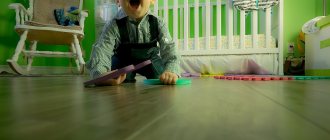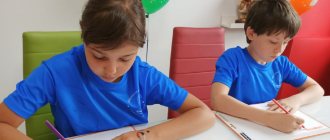When should you contact a speech pathologist?
Signs of violations sometimes appear individually, sometimes in combination. In the first case, parents can attribute these phenomena to an age crisis, since many pathologies make themselves felt just at the age of 2.5-3 years. Therefore, parents of three-year-olds should be especially vigilant. We recommend urgently showing the child to a defectologist if:
- speech development lags behind the age norm, the child does not speak at all or has an extremely poor vocabulary, prefers gestures, facial expressions, “his own language”;
- the baby does not understand the speech of an adult (with normal hearing), cannot fulfill simple requests;
- the child seems to be “in his own world”, he avoids communication with peers and adults;
- does not like to communicate with other children, often plays alone, and the game consists of them and the same repeated actions;
- has difficulty coordinating movements, cannot perform actions that require precise movements;
- does not obey, throws tantrums for no apparent reason;
- poorly assimilates information, cannot establish cause-and-effect relationships, and thinks slowly.
It is extremely important not to waste time and contact a defectologist as soon as you notice at least one of the listed signs.
Year of study: 3
Main goal : to consolidate the idea of geometric shapes - circle, square, oval, triangle, rectangle.
Tasks:
Priority area: “Cognitive development”:
- Consolidating the idea of geometric shapes.
- Developing children’s ability to distract from other features in the process of choosing a given shape: color and size.
- Development of visual-figurative thinking, analytical-synthetic activity (the skill of mental synthesis of parts into a single whole, its recognition and correlation with a model; development of the skill of understanding the principles of alternation, its continuation).
- Development of attention.
Integration of educational areas:
“Speech development”:
- Development of understanding of addressed speech, speech instructions;
- Enrichment of vocabulary;
- Development of the planning function of speech.
“Artistic and aesthetic development”:
- Development of the ability to draw geometric shapes with a simple pencil, observing the line and size of the shapes.
"Physical development":
- Development of general motor skills.
Formed prerequisites for UUD:
- developing the ability to take into account someone else’s point of view;
- development of the ability to maintain a task throughout the entire duration of the task;
- formation of sensory standards;
- developing the ability to listen to an interlocutor.
Equipment : doll, drawings of “tips”, a set of geometric shapes of different colors and sizes; geometric figures cut into 2-3 parts and the same whole ones (samples), a gymnastic mat, individual leaves with the alternation of geometric figures begun, simple pencils.
MOVE GCD
- Org moment.
- Hello guys. You know, today is our doll Katya’s birthday. Shall we congratulate her? Only she decided to play with us and hid from us. What do we do? (look for her). The Katya doll left us clues, but to get them, we need to complete the task. Ready?
- P. Game “Arrange the figures” . (On the tray there are geometric shapes of different sizes and colors - circles, squares, triangles, rectangles, ovals).
- Guys, look, Katya has mixed all the figures, let’s sort them out? We will put such figures in this plate. Misha, what kind of geometric figure is this? (Circle) This one contains such figures. Dasha, what is it called? (Oval), etc. Children lay out geometric shapes.
- Well done, they sorted everything out!!! (The teacher raises the tray, under it there is a hint - an image of a red table). Look, we've found the first clue. What is shown here? Let's go to the red table.
- P. Game “What kind of figure.” (On the table there are geometric figures - samples, and the same ones, cut into 2-3 parts. The parts of one figure are close to each other so that you can find out what they are).
- Look what happened? The figures were torn apart. Let's try to guess what it is?
— Dima, what kind of figure do you think this is? (Child's answer). Let's check, fold it (the child folds the figure and moves it to the sample).
- Lena, what is this? (After the children have completed the task, the teacher finds the next clue under one of the figures - a drawing of a gymnastics mat and an ear).
- F. Physical education (teacher and children move to the mat).
- Guys, I think here Dasha is inviting us to play the game “Attentive Ears.” I will name different geometric shapes, and you will perform a certain action. When I name the circle, what will we do? (children's suggestions, for example, clap your hands). Square? Triangle?
-Well done boys. Let's fold the rug and put it back in place. (When rolling up the gymnastics mat, children find the next clue - an image of yellow and blue tables)
- P., H-E. Game “Continue the drawing” (Prepared individual tasks and simple pencils are on the table).
— Dasha began to draw geometric shapes in a certain sequence, but did not finish the lines. Shall we finish it?
— Ilyusha, what figures do you alternate? How will you continue to draw?
- Lisa? What kind of figures do you have? How will you continue? Etc.
(Children complete the drawings of the figures, observing the principle of alternation. The teacher completes the task on his piece of paper).
- Everyone is finished, let's check (Children take turns showing their drawings, the rest “check”). I finished it too, right? (The teacher shows his drawing and “accidentally” turns it over; a cabinet is drawn on the reverse side. The children report this to the teacher).
- Summarizing. Reflection. (The children and the teacher go to the closet and find a doll there)
- Guys, look, here is our birthday girl. Let's tell her what we did? What did you like most?
- Well done, I also liked how you handled everything, you were especially active... And now let’s go congratulate the doll Katya? (Transition to the role-playing game “Katya’s doll’s birthday”).
The child has Down syndrome
The main goal of the classes is to prepare the child for social adaptation, teach important work skills, and form the correct forms of behavior in him. These results can only be achieved with an integrated approach and early diagnosis of the disorder:
- development of memory, thinking, speech, attention;
- encouraging the pursuit of knowledge;
- development of sensory perception;
- taking into account interests and zones of proximal development.
The classes use simple material that is accessible to the child, and it is repeated as many times as necessary to fully assimilate it.
The most important condition for successful correction of developmental disorders is early diagnosis . If your child is 2.5-3 years old, take a closer look at him. If you find any warning signs, contact a speech pathologist as soon as possible.
Publication date: 04/19/2021. Last modified: 11/25/2021.
How are classes with a defectologist?
Depending on the age of the child, classes have their own specifics. Let's tell you more about them.
From 1.5 to 3 years
Classes are aimed at teaching the child to communicate with adults, to play (play activity before entering school is the leading one), as well as to form sensory standards (color, shape, size), develop attention, memory, and thinking. With the help of special exercises and games, the defectologist develops auditory, tactile and visual perception.
From 3 to 5 years
Exercises and games are selected in such a way as to correct problematic behavior and create in the child a desire to explore the world around him. In addition, the defectologist teaches the child to navigate in space, perceive and correlate objects by color, size and shape, think logically, and concentrate on the task at hand. Particular attention is paid to the development of attention, memory, and the ability to analyze and synthesize information.
How can a defectologist help if a child has been seriously diagnosed?
Thanks to timely diagnosis and attentive attitude of parents, many serious disorders - mental retardation, autism and ASD, mental retardation can be identified early, at the age of 2.5-3 years. For such children and parents, the defectologist is the main teacher; it is he who builds an individual program of development, training and education, and socialization.
The child has mental retardation
Mental retardation is a disorder in which a number of higher mental functions (attention, thinking, emotional-volitional sphere, memory) mature later than expected by age. A defectologist has to solve several problems at once:
- development of attention, perception, speech, thinking, memory;
- teaching gaming activities;
- accumulation of sensory impressions;
- formation of knowledge about the surrounding world.
During classes, the teacher encourages the child’s creative activity by offering different options for tasks. As you progress, the learning material gradually becomes more complex.
The child has autism or ASD
The purpose of the classes is to compensate for deficiencies in the baby’s development that were identified during the examination. During diagnosis, the defectologist evaluates the following points:
- whether the child can imitate an adult and act according to verbal instructions;
- is he able to draw up an action plan and follow it;
- does he distinguish objects by color, shape, size;
- how developed are the motor and sensory areas;
- does the child confidently navigate in space, can he name and show parts of the body;
- how quickly the baby learns information, whether he can switch from one task to another, and whether he avoids participation;
- how the child behaves when communicating, how he reacts to the need to participate in the conversation.
As we have already said, exercises and games are selected to overcome identified developmental deficiencies. Classes with a speech pathologist are an important part of the correction program.
The child has mental retardation
Correctional training is carried out in several directions at once:
- development of the emotional-volitional sphere, attention, memory, imagination;
- development of all types of thinking;
- accumulation of knowledge about the world around us, replenishment of vocabulary, development of speech;
- sensorimotor development.
Classes with a defectologist are of an applied nature, that is, the child learns independence and masters communication skills with peers and adults.
Who is a special education teacher?
While working at school for the 2nd year, I encountered some problem, which prompted me to publish this material. The problem lies in the expression: “Nobody knows who a defectologist is, but everyone knows who he should work with.” To my great regret, I am not only talking about parents. When it comes to a special education teacher, many parents panic. Many of them begin to be indignant - “What kind of defectologist!!! My child has no defects!!! He’s normal with us!!!” Many parents think that if a child goes to a defectologist, it means that he now has problems for life. More than once I have heard the phrase that a defectologist is a teacher who teaches, excuse me, fools. And the teachers would send all the children to him!!
So who is this defectologist? What kind of horror story is this for parents?
A defectologist is a specialist who studies, trains, educates and socializes children with disabilities. A speech pathologist also works with children who have learning difficulties. In other words, a special education teacher works with children who do not understand and are not taught according to the general education school curriculum. He can also work with children who, for various reasons, do not master the general education curriculum a little or have difficulty learning. These are mainly primary school students. The work of a teacher-defectologist is the mental development of the child and the development of his cognitive abilities.
The profession of a defectologist is at the intersection of medicine and pedagogy and includes many specialties: teacher of the deaf (works with children with hearing impairments), oligophrenopedagogist (with mental disabilities), typhlopedagogist (with visual impairments), speech therapist (with speech impairments).
What exactly do I do? The content of my work is contained in the tasks.
- My work begins with diagnosis. Diagnostics are carried out more than once. And diagnostics are carried out only at the request of teachers and parents. I can't come to class and just take Petya or Masha. Diagnosis requires justification.
- In parallel with the diagnosis, I identify the difficulties and problems that a child may have if the disorder is not corrected in time.
- Based on the diagnostics performed and the identification of the child’s immediate developmental zone, an individual correctional and developmental program is drawn up for each child or group of children.
- Then the correction process itself is carried out, which is carried out in group, subgroup and individual classes.
- In parallel with the correction, dynamic observation of the child’s entire educational process is carried out, and not only in defectology classes.
- There is also consultation between teachers and parents on issues of interest.
The purpose of my work, to put it in my own words, is correction! Those. correction of developmental gaps.
The work of a speech pathologist teacher contains many areas. The main ones are the following:
1 block “development of psychomotor and sensory processes.” This is a very large block, the main focus of which is to correct fine motor skills. After all, as you know, if fine motor skills are not developed, there is no writing, and if there is no writing, there is no coherent speech.
Block 2 “formation of spatio-temporal relations.” Here we study not only concepts such as “right and left”, but also such concepts as “upper right corner”, “lower left corner”, “2-dimensional and 3-dimensional space”. If this area is underdeveloped, problems with reading and writing may arise.
Block 3 “mental development”. This is also a very large direction in which HMFs are corrected, such as memory, thinking, analysis and synthesis, etc.
Block 4 “normalization of the leading activities of age.” As you know, the leading activity of students during their age is learning. Unfortunately, this is not the case for everyone, especially for elementary school students and students enrolled in correctional programs of types 8 and 7. For them, as a rule, for a very long time the leading activity of their age is gaming.
Block 5 “formation of ideas about objects and phenomena.” In this direction, those problems that arose in connection with gaps in previous development are corrected. For example, the child did not go to kindergarten. Here such ideas as color, shape, size, etc. are formed. This is also a very important direction, because it is a prerequisite for the development of mathematical skills.
Block 6 “enrichment of vocabulary and development of coherent speech.” The name of this direction speaks for itself and, of course, it applies more to speech therapists, but a defectologist should not ignore it.
Block 7 “readiness to perceive educational material.” This block is aimed primarily at 1st grade students. It helps them prepare to learn a lot of new educational material.
Block 8 “formation of skills and abilities necessary for mastering program material.” This block is aimed mainly at students in grades 2-4. As a result of correction in this area, students develop the knowledge and skills that help them master the educational material.
As can be seen from the above, the teacher-defectologist does not teach children mathematics or the Russian language (although these classes are carried out in the correctional process). My classes are such that, first of all, I correct the cause of the difficulty that has arisen, as a result of which the impaired functions are corrected. For example, due to unformed spatial concepts, difficulties in writing and reading result. They can be compensated by work aimed directly at developing reading and writing (which is what the teacher does) as well as by developing spatial concepts in the child (which is what the defectologist does).
Short terms for obtaining a visa to Italy.
The defectologist's office is a kind of fairy tale where children end up.
The structure of my defectology classes is very diverse and interesting. The range of developmental aids is so large that children, while playing seemingly simple games with great interest, do not notice how they are learning something. Each lesson is a whole complex for the development of cognitive activity, motor skills, speech, phonetic hearing, etc. In the lessons, toys, paintings, books, a computer, sand, pine cones, buttons, puppet theater and many other various didactic materials are used.
Here are some examples of activities.
1. educational coloring pages
At first glance it looks like an ordinary coloring. What is actually being practiced is a math skill. Those. To color the picture, you need to solve the examples. A certain color corresponds to a certain number. As a result, not only mathematical skills are formed, but also sensory processes (color consolidation), spatial skills are consolidated and fine motor skills are developed.
2. Working with flannelgraph.
In this lesson, space-time direction is practiced. The seasons are studied. It seems like nothing unusual, but children are wildly delighted when ordinary pieces of paper without glue are glued to fabric. For them this is real magic. In addition, thinking, fine motor skills, and speech develop.
3. Working with sand.
Nothing unusual either... But if you close your eyes... Put your hands in this warm sand... imagine that the bright sun is shining in the sky, that birds are singing nearby... The result is the development of fine motor skills, sensory processes, imagination, and speech. You can also practice counting and reading skills in this tutorial.
4. working with clothespins.
Using clothespins we add the missing elements. As a result, not only fine motor skills are corrected, but also coherent speech, thinking, vocabulary, etc. After all that has been said and shown, I think every parent will change his opinion about correctional defectology classes and will want his child to attend such interesting and exciting classes.
And in conclusion, I wish you, parents, success, patience, wisdom in raising and teaching your children.
Author of the material: Teacher speech therapist-defectologist Lapteva Daria Veniaminovna
Also on topic:
What problems do speech pathologists identify and solve?







